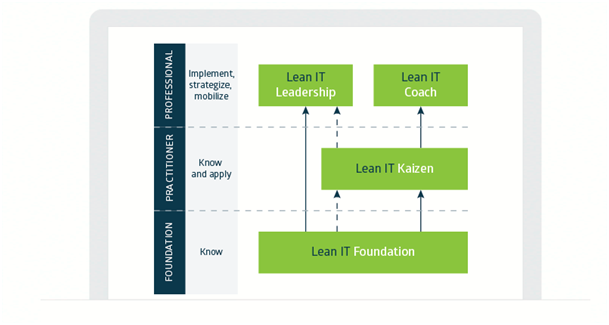-
IT Service Management & BIM
Organizations need to rely on an IT service that supports their processes well. With the increasing importance of ICT in the business, the demands of customers in the IT services are rising. Think of high availability, always the right capacity, optimization of costs, flexibility, appropriate support and a short time-to-market. Read more.
-
The 8 most frequently asked questions about ITIL®, ASL®, BISL® and LEAN-IT training courses.
1.What is ITIL®ITIL® is a process model that, based on best practices, gives insights in the setup of an IT service organization. Insights like what you have to do to become an effective and efficient IT partner for your clients. In other words it helps you to create value for your customers. The letters “ITIL®” stand for ‘Information Technology Infrastructure Library’. It offers guidelines for setting up management processes inside an IT organization.
ITIL® isn’t an organisational model. It’s a description of a large amount of processes (Library) which are necessary for flexible services. The second ‘I’ stands for ‘Infrastructure’. This could arouse suspicion that ITIL® only applies to the technical side of automation. In most organizations the ITIL® initiative is traditionally started within the ‘Infrastructure Management’ departments. But in ITIL®, the term ‘Infrastructure’ literally covers ANYTHING that’s needed to deliver service, but also to design and build services.
The first two letters, ‘IT’, stand for ‘Information Technology’ and indeed… In ITIL® literature, all processes and best practices are described from the perspective of an IT service provider. But this doesn’t mean that in only applies to IT services providers. Any service provider, whatever it nature (hospitality, transport, logistics), can benefit from the knowledge and insights within the ITIL® literature.
2. What is ASL®?
Because ITIL® was initially used within the ‘Infrastructure Management’ department and ITIL® focused on the needs of this department, application management wasn’t a priority. Then, in the Netherlands ASL® was developed, which stands for ‘Application Services Library’. With all due respect, we could say that ASL® is kind of an ITIL®. But then specifically described from the perspective and needs of an application management organization. This time also with a large amount of processes (Library), specifically for services that are only for developing and managing applications.
ASL® has gained a lot of importance since the amount of independent application management organizations, who focus on delivering applications while infrastructure management is outsourced elsewhere, has risen.
3.What is BISL®
Because IT service providers became more mature by using ITIL® and ASL® there was a need for more mature customers. A customer that understand their needs and knows how to translate that into the right questions for IT service providers. Customer that take their responsibility in the best possible way.
And this is not just the business organization (that defines the organization) but specifically the information aspects of the business processes.
For this reason BiSL® was developed which stands for ‘Business Information Services Library’.
Like ITIL® and ASL® are instruments for the employees in an IT organization, BiSL® is an instrument for employees who are responsible for the information needs in the business processes. That includes ALL information needs, not just the information needs for the automated information provision (IT solution). And this goes further then just the operational needs. This also includes the tactical and strategic needs. So BiSL® also provides guidance for making the information provision future proof.
4.Which Foundation training course should I attend?
In the old days it were just people working at an IT department that attended an ITIL® training course. Nowadays a lot of organizations realize the power of using ITIL®. There are several levels of ITIL® training courses. However the ITIL® Foundation is a great training course to learn the basic concepts and terminology and understand how to work together with other organizations (IT or not). This training course also explains how ITIL® relates to other frameworks like LEAN or SCRUM.
For people that work in an application management organization that delivers it’s own services to customers ASL® Foundation might be the right training course.
The BISL® Foundation is the right choice for people working in Business Information Management. So that would be anyone involved in managing the information provision and supporting the informational needs of the business processes. This includes anyone that will close the gap between business and IT from the business side and anyone that will make sure IT service providers can provide the best possible solutions. This includes people in operation, but also on a tactical and strategic level.
5.Welke vormen van ITIL® certificeringen zijn er en welke is voor mij het beste geschikt?
 ITIL © 4 was introduced in 2019. ITIL © 4 has been further evaluated from ITIL 3 and has placed a number of issues in a broader context, such as value streams, customer experience and digital transformation. Furthermore, new ways of working have been embraced such as Agile, LEAN and DevOps. As a result of this adjustment, the focus has shifted to end-to-end realization of products and or the provision of services. The end-to-end service provision is realized by developing ITIL service value streams. These ITIL service value streams will ultimately realize the value for the customer. This is done on the basis of value co-creation.
ITIL © 4 was introduced in 2019. ITIL © 4 has been further evaluated from ITIL 3 and has placed a number of issues in a broader context, such as value streams, customer experience and digital transformation. Furthermore, new ways of working have been embraced such as Agile, LEAN and DevOps. As a result of this adjustment, the focus has shifted to end-to-end realization of products and or the provision of services. The end-to-end service provision is realized by developing ITIL service value streams. These ITIL service value streams will ultimately realize the value for the customer. This is done on the basis of value co-creation.The value is realized by the newly developed Service value system (SVS). The model contains the five core components:
- Guiding principles;
- Governance;
- Service value chain;

- Practices (in ITIL3 these were the processes);
- Continual improvement.
See the training schedule to the right for following the training in which the cooperation between these components is discussed.
You obtain the title of ITIL Managing Professional (MP) after you have completed the Foundation and the four follow-up modules. To be able to take an exam for the four modules you must have obtained the Foundation certificate and followed the training at an Accredited Training Organization (ATO), for example Capgemini.
Copyright © AXELOS Limited 2019. Used under permission of AXELOS Limited. All rights reserved.Figure 4.1 The ITIL service value system, ITIL Foundation, ITIL® 4 edition
6.What is LEAN-IT
Originally LEAN was developed by the production company Toyota and is already there for over 50 years. Using LEAN is one of the most important reasons why Toyota is so successful.
The essence of LEAN is involving all employees of your organization in the process of creating value and removing waste in production.
LEAN is very successful, so why not adopting LEAN in an production company of non physical products?
And yes, LEAN can also be used to improve service processes. In LEAN-IT we look into the role of a service organization in a value chain and translate the LEAN best practice into a service organization. LEAN-IT is no alternative for e.g. ITIL® processes but a mindset that can help you improve your ITIL® processes. This can be done by e.g. removing bureaucracy and other waste and making sure that all employees are involved and can actively participate in adding value to the customer.
LEAN-IT is the First step to achieve the international recognized LEAN certification.
The training course LEAN-IT is available for registration on our website. All other LEAN training courses are available on request and will be provided in company. These training course are customer specific by definition.

7. How about DevOps and Agile in an ITIL® based environment?
We meet a lot of people that think process based working and Agile based working are opposites. But this is a big misunderstanding. When using ITIL® you can use an agile approach as well. And this also goes for DevOps. The concepts of DevOps can be found in ITIL®. Although the 4 ITL® functions are mainly addressed in the Service Operation stage ITIL® will explain that it is all about the integrated approach of the service lifecycle and that will involve all disciplines
You might need some additional tools and translation. But just like Agile and the translation to e.g. SCRUM also ITIL® is about continual improvement in small gradual steps. Many of this aspects can be found in the ITIL® stage CSI that stands for Continual Service Improvement.
8.What is DevOps?
Ask this question to 100 people and you will get 100 different answers. But many of those answers have these elements in common:
- DevOps is a next step in Agile. Where Agile focuses on iterative and incremental development of products, in DevOps we extend this to deliver those products quickly, safely and without risk to the end users. Where we have broken down the ‘wall’ between end-user and developer in Agile, in DevOps we break down the ‘wall’ between development (Dev) and operations (Ops). In addition, we make teams responsible for both the development and the operations of a product ("You build it, you run it"). This often requires a significant cultural change.
- DevOps also focuses on automating (in the end) all the steps needed to get a product delivered to the end user quickly, safely and without risk: "automate everything". This includes mostly automated testing, automated infrastructure and a lot of "as a service" concepts.
- Within DevOps continuous feedback, both from a technical and a functional point of view, plays a crucial role to get ever better products and an ever better process. This includes a culture of continuous improvement and experimentation, where we don’t mind making mistakes as long as we learn from them.
Are you looking for a complete, but brief overview of all aspects of DevOps? Then our half day classroom training DevOps Awareness is the right one for you!
9. If we start using ITIL®/ASL®/BISL®/LEAN IT do we still need a specific level of expertise on e.g. testing, programming, communicating and so on?
All these frameworks do not replace a specific level of expertise on other subjects. If you just understand ITIL® you can’t manage a datacenter. If you just know ASL® you can’t built an application. If you want to build an application you also need knowledge and skills on e.g. programming, architecture and testing.
And BISL® does not replace the need for knowledge on business processes. Quit the contrary. Without knowledge on the business processes an implementation of Business Information Management (BIM) using BiSL® is not very likely to succeed.
For specific training on IT/ Development we have a large number of training courses as well.
So it doesn’t matter what framework you use, you always need additional knowledge and skills. Capgemini Academy provides a lot of training courses. Feel free to check them out and find the training course you need.
And if you have any questions, or need some guidance to find the right training course for you, please contact us by sending an email using our contact us option on our website.
Business Information Management (BIM)
Within the complexity of today's market, businesses simply cannot do without properly functioning information technology (IT). As such, IT is one of the most important aids for the implementation of any business strategy. The most critical points are found in the alignment of IT with business processes. It is precisely this alignment that is often far from optimum. Business information administrators and information managers bear final responsibility for this alignment.
According to BiSL, Business Information Management is the management domain by which an organization efficiently plans, collects, organizes, uses, controls, disseminates and disposes of its information, and through which it ensures that the value of that information is identified and exploited to the fullest extent. Business Information Management refers to the activities that organizations perform in order to ensure that they are using information in an appropriate manner and that they are acquiring and using the appropriate information systems.
BiSL®
BiSL® is an abbreviation of Business Information Services Library. BiSL is a vendor independent public domain library for the implementation of business information management. The library consists of publications describing a process framework for business information management and a large number of best practices, white papers, articles and presentations. The standardized approach of BiSL contributes to the professionalization of the demand organization and facilitates a more efficient and cost effective way of working. It provides a common language and reference to the market, facilitating a better understanding and communication between the parties involved in information provision.
Training courses
Capgemini Academy provides a lot of training courses related to Business Information Management. For BiSL we have the Anytime Anyplace training course that is entirely available in the English language. Most classroom training courses can also be provided in English. However the scheduled sessions in our office are usually scheduled in Dutch. If you are interested in English classroom training courses please contact our customer service department.
All our training courses are provided by experienced trainers that speak English.
BiSL vs. BiSL Next
Discussions with participants in our training sessions have shown that there is some confusion about the correct assessment of the BiSL and BiSL Next frameworks. In order to remove this ambiguity, we share Capgemini Academy's vision on this topic on this page.




